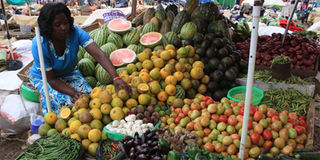Inflation seen muted in the coming months

A vegetable and fruit vendor in Nyeri. Kenya’s Inflation dropped to a six-month low of 4.1 percent, mainly due to lower prices. of food items. PHOTO | JOSEPH KANYI | NMG
What you need to know:
- This is mainly due to lower prices of food items such as maize grain and flour, green vegetables and sugar on a year-on-year basis.
- Food accounts for 36 percent of the consumer price index basket, hence its oversized effect on the headline inflation numbers.
- Experts say low food inflation should keep the rise in cost of living closer to the lower end of the central bank preferred range of 2.5 to 7.5 percent, at least until later in the year.
The rise in cost of living is expected to moderate further in coming months due to continued fall in food prices that should cancel out any inflationary effects of higher fuel prices, analysts have said.
In February, Kenya’s inflation dropped to a six-month low of 4.1 percent, mainly due to lower prices of food items such as maize grain and flour, green vegetables and sugar on a year-on-year basis.
Although fuel prices have come down in the last three review cycles after crude prices fell in the last quarter of 2018, the gradual recovery since January means that pump prices may start to rise starting next month (due to the lag effect in delivery of refined imports).
Analysts at Commercial Bank of Africa (CBA) say the combination of the lower food prices and muted demand side pressure should, however, be enough to iron out rise in fuel costs, hence keep inflation edging downwards.
“The anticipated increase in pump prices, consistent with the recent trends in global oil prices should be offset by the generally stable food inflation outlook as well as subdued core inflation,” said CBA in a note on inflation.
Food inflation
Food accounts for 36 percent of the consumer price index basket, hence its oversized effect on the headline inflation numbers.
Economists at global lender Citi also hold the view that low food inflation should keep the rise in cost of living closer to the lower end of the central bank preferred range of 2.5 to 7.5 percent, at least until later in the year.
Citi chief Africa economist David Cowan said earlier last week that towards the end of 2019, only the base effect of very low food prices seen in quarter four of last year would present an upside risk on inflation.
“Food inflation, led by fresh food prices, has been consistently above the overall rate of inflation in recent years, but this has not been the case since the second half of 2018…. something that is not common,” said Mr Cowan.
“Inflation is unlikely to go up soon and we can only see it picking up towards the five percent levels at year end due to the base effect.”



